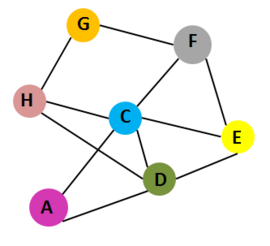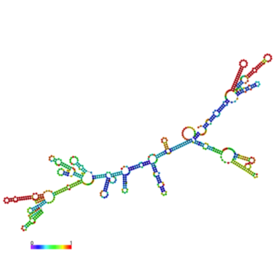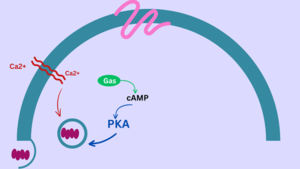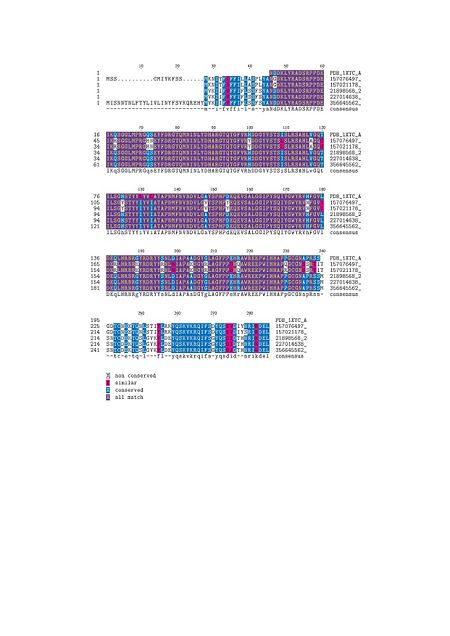Cholera toxin
From Proteopedia
(Difference between revisions)
| Line 17: | Line 17: | ||
== Function == | == Function == | ||
Cholera toxin, after being secreted from the ''Vibrio cholerae'', binds to the enterocytes (intestinal cells) by the interaction between the subunit B and GM1 ganglioside[http://en.wikipedia.org/wiki/GM1] receptor on enterocytes, which then promotes the toxin endocytosis. Next, A1 turns to an active enzyme after separating with the A2 domain. After the A1 domain of subunit A of the toxin enters the cytosol, it activates adenylate cyclase to produce cAMP through G proteins, which triggers the activation of cystic fibrosis transmembrane conductance regulator (CFTR), leading to watery diarrhea: the efflux of water and ions from cells <ref>Jennifer McDowall, Cholera Toxin, EMBL-EMI, Interpro</ref>. | Cholera toxin, after being secreted from the ''Vibrio cholerae'', binds to the enterocytes (intestinal cells) by the interaction between the subunit B and GM1 ganglioside[http://en.wikipedia.org/wiki/GM1] receptor on enterocytes, which then promotes the toxin endocytosis. Next, A1 turns to an active enzyme after separating with the A2 domain. After the A1 domain of subunit A of the toxin enters the cytosol, it activates adenylate cyclase to produce cAMP through G proteins, which triggers the activation of cystic fibrosis transmembrane conductance regulator (CFTR), leading to watery diarrhea: the efflux of water and ions from cells <ref>Jennifer McDowall, Cholera Toxin, EMBL-EMI, Interpro</ref>. | ||
| - | + | [[Image:Picture1.png|right|300px|thumb|Structure Notation of the RNA of CTX A, CLC RNA Workbench]] | |
== Evolution == | == Evolution == | ||
CTXφ Bacteriophage which is carried by ''Vibrio cholerae'' produces Cholera toxin. Cholera toxin is encoded by the ctxA and ctxB genes that are introduced into V. cholerae strains by horizontal gene transfer <ref>Davis B, Waldor M (2003). "Filamentous phages linked to virulence of Vibrio cholerae". Curr Opin Microbiol 6 (1): 35–42. doi:10.1016/S1369-5274(02)00005-X. PMID 12615217.</ref>. | CTXφ Bacteriophage which is carried by ''Vibrio cholerae'' produces Cholera toxin. Cholera toxin is encoded by the ctxA and ctxB genes that are introduced into V. cholerae strains by horizontal gene transfer <ref>Davis B, Waldor M (2003). "Filamentous phages linked to virulence of Vibrio cholerae". Curr Opin Microbiol 6 (1): 35–42. doi:10.1016/S1369-5274(02)00005-X. PMID 12615217.</ref>. | ||
| Line 23: | Line 23: | ||
== Application == | == Application == | ||
Subunit B of cholera toxin is designed to be applied as a neuronal tracer due to its non-toxic characteristic. It also used to identify lipid rafts as florescent tag on the cell surface since lipid rafts contains GM1 gangliosides, which will interact with subunit B during mechanism <ref>Luppi P.H.. "The Discovery of Cholera-Toxin as a Powerful Neuroanatomical Tool". Retrieved 2011-03-23.</ref>. It is demonstrated that cholera toxin subunit B is a sensitive retrograde tracer for the central nervous system <ref>Luppi P.H., Fort P., Jouvet M. Iontophoretic application of unconjugated cholera toxin B subunit (CTb) combined with immunohistochemistry of neurochemical substances: a method for transmitter identification of retrogradely labeled neurons. Brain Res. 534 (1-2) pages : 209-224 (1990)</ref>. | Subunit B of cholera toxin is designed to be applied as a neuronal tracer due to its non-toxic characteristic. It also used to identify lipid rafts as florescent tag on the cell surface since lipid rafts contains GM1 gangliosides, which will interact with subunit B during mechanism <ref>Luppi P.H.. "The Discovery of Cholera-Toxin as a Powerful Neuroanatomical Tool". Retrieved 2011-03-23.</ref>. It is demonstrated that cholera toxin subunit B is a sensitive retrograde tracer for the central nervous system <ref>Luppi P.H., Fort P., Jouvet M. Iontophoretic application of unconjugated cholera toxin B subunit (CTb) combined with immunohistochemistry of neurochemical substances: a method for transmitter identification of retrogradely labeled neurons. Brain Res. 534 (1-2) pages : 209-224 (1990)</ref>. | ||
| + | |||
| + | == Multiple Sequence Alignment == | ||
| + | [[Image:MSA1.jpg|left|450px|thumb|Multiple Sequence Alignment-TEXSHADE result.BlastP of CTX A subunit that contains six different species. This is made by Biology Workbench]] | ||
| + | {{Clear}} | ||
| + | '''Selected Sequences:''' | ||
| + | |||
| + | 1. Cholera toxin Subunit A | ||
| + | |||
| + | 2. Escherichia coli E24377A plasmid pETEC_80, complete sequence | ||
| + | |||
| + | 3. Escherichia coli strain 214-III elt operon, complete sequence | ||
| + | |||
| + | 4. Vibrio cholerae strain JS9803 prophage Vibrio phage CTX Zot (zot) | ||
| + | |||
| + | 5. Vibrio cholera O395 chromosome II, complete sequence | ||
| + | |||
| + | 6. Vibrio cholera O1 str. 2010EL-1786 chromosome 1, complete | ||
| + | [[Image:TREE - MAXIMUM LIKEHOOD.PNG|left|430px|thumb|Phylogenetic Tree of MSA of CTX, Statistic Method:Maximum Likelihood, made by MEGA 5.05]] | ||
</StructureSection> | </StructureSection> | ||
| + | == External Links == | ||
| + | PDB ID: 1XTC [http://www.rcsb.org/pdb/101/motm_disscussed_entry.do?id=1xtc] | ||
| + | |||
| + | MMDB ID: 52036 [http://www.ncbi.nlm.nih.gov/Structure/mmdb/mmdbsrv.cgi?uid=52036] | ||
| + | |||
| + | PubMed[http://www.ncbi.nlm.nih.gov/pubmed/7658473?dopt=Abstract] | ||
== 3D Structures of Cholera toxin == | == 3D Structures of Cholera toxin == | ||
| Line 29: | Line 53: | ||
{{#tree:id=OrganizedByTopic|openlevels=0| | {{#tree:id=OrganizedByTopic|openlevels=0| | ||
| - | + | ||
| - | + | ||
* CTX | * CTX | ||
| Line 54: | Line 78: | ||
}} | }} | ||
== See also [[Toxins]] == | == See also [[Toxins]] == | ||
| - | == Multiple Sequence Alignment == | ||
| - | [[Image:MSA1.jpg|left|250px|thumb|Multiple Sequence Alignment-TEXSHADE result.BlastP of CTX A subunit that contains six different species. This is made by Biology Workbench]] | ||
| - | '''Selected Sequences:''' | ||
| - | |||
| - | 1. Cholera toxin Subunit A | ||
| - | |||
| - | 2. Escherichia coli E24377A plasmid pETEC_80, complete sequence | ||
| - | |||
| - | 3. Escherichia coli strain 214-III elt operon, complete sequence | ||
| - | |||
| - | 4. Vibrio cholerae strain JS9803 prophage Vibrio phage CTX Zot (zot) | ||
| - | |||
| - | 5. Vibrio cholera O395 chromosome II, complete sequence | ||
| - | |||
| - | 6. Vibrio cholera O1 str. 2010EL-1786 chromosome 1, complete | ||
| Line 74: | Line 83: | ||
<references /> | <references /> | ||
| - | == External Links == | ||
| - | PDB ID: 1XTC [http://www.rcsb.org/pdb/101/motm_disscussed_entry.do?id=1xtc] | ||
| - | |||
| - | MMDB ID: 52036 [http://www.ncbi.nlm.nih.gov/Structure/mmdb/mmdbsrv.cgi?uid=52036] | ||
| - | PubMed[http://www.ncbi.nlm.nih.gov/pubmed/7658473?dopt=Abstract] | ||
[[Category:Topic Page]] | [[Category:Topic Page]] | ||
Revision as of 13:02, 18 January 2016
| |||||||||||
Contents |
External Links
PDB ID: 1XTC [1]
MMDB ID: 52036 [2]
PubMed[3]
3D Structures of Cholera toxin
Updated on 18-January-2016
See also Toxins
Reference
- ↑ Ryan KJ; Ray CG (editors) (2004). Sherris Medical Microbiology (4th ed.). McGraw Hill. p. 375. ISBN 0838585299.
- ↑ Faruque SM; Nair GB (editors). (2008). Vibrio cholerae: Genomics and Molecular Biology. Caister Academic Press. ISBN 978-1-904455-33-2.
- ↑ Jennifer McDowall, Cholera Toxin, EMBL-EMI, Interpro
- ↑ Jennifer McDowall, Cholera Toxin, EMBL-EMI, Interpro
- ↑ Davis B, Waldor M (2003). "Filamentous phages linked to virulence of Vibrio cholerae". Curr Opin Microbiol 6 (1): 35–42. doi:10.1016/S1369-5274(02)00005-X. PMID 12615217.
- ↑ Luppi P.H.. "The Discovery of Cholera-Toxin as a Powerful Neuroanatomical Tool". Retrieved 2011-03-23.
- ↑ Luppi P.H., Fort P., Jouvet M. Iontophoretic application of unconjugated cholera toxin B subunit (CTb) combined with immunohistochemistry of neurochemical substances: a method for transmitter identification of retrogradely labeled neurons. Brain Res. 534 (1-2) pages : 209-224 (1990)





